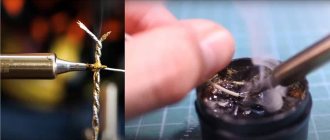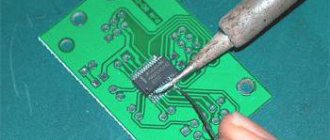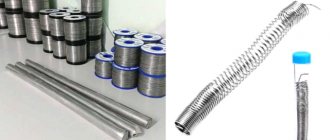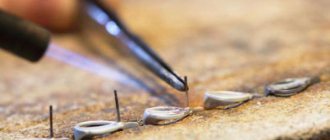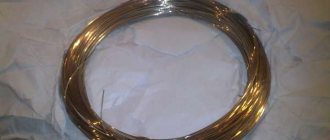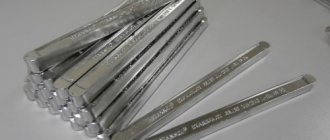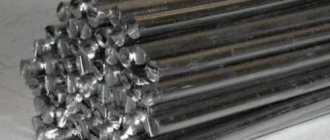Legislative initiative or trend of the times
Why is it now that lead-free solders have so quickly begun to gain ground over traditional compounds? The fact is that the EU Directive “On the Restriction of the Use of Hazardous Substances” (adopted in 2003 and entered into force on July 1, 2006) obliged to limit the use of lead (and five other substances) in the production of electrical and radio-electronic devices. This is due to the requirements of environmental safety and human health. Lead belongs to the group of heavy metals, and its vapors are highly toxic.
Although adherents of the usual POS-40 solder should not be upset. It is still produced and sold. In many countries, tin-lead solders are used in the transport, military and aerospace industries.
Eliminate the use of lead. Lead-free technology
For over 50 years, lead soldering has been used throughout virtually the entire electronics industry for mounting components onto printed circuit boards. However, the future of this technology is in great doubt due to growing concerns about increasing lead levels in soil and ultimately lead leaching into drinking water. Despite scientific evidence that shows that the electronics industry's impact on lead levels in the environment is extremely small, there is a movement to ban the use of lead in the electronics industry.
In October 2002, Europe approved legislation banning the use of lead in most electrical and electronic products, effective July 1, 2006. Additional legislation governing the use of lead in the European automotive industry came into force on 1 July 2003. Although the legislation directly affects only the European Community, all companies that supply to Europe must also comply with the new rules.
Lead in electronics
There are three main lead-containing components in electronic products: solder, printed circuit board pad coating, and electronic component lead coating. In a typical solder joint, the solder is the main determinant of the presence of lead. Accordingly, the coating of the printed circuit board and the leads of electronic components have a much smaller impact on the lead content. As a result, the first steps towards reducing lead content in electronic products were aimed at finding an alloy to replace traditional lead-containing solders. Nowadays, solder is used in most cases of mounting electronic components on a printed circuit board:
- surface mount technology (solder is used in the form of a paste, which is applied to the surface of the printed circuit board using a special template or stencil);
- installation into board holes (molten solder is used, which is located in a special bath);
- manual soldering using a soldering iron (as a rule, solder is used in the form of a wire, thin tube or tape).
As a result of numerous experiments over the past few years, a family of tin, silver, and copper (SnAgCu) alloys have been proposed as replacements for lead-containing solders. For surface mount technology, SnAgCu alloy is likely to become the most popular solution. Perhaps the biggest problem with using such an alloy as a solder is the higher melting point. For example, the melting point of SnAgCu alloy is 217°C, while the tin-lead alloy Sn37Pb melts at 183°C. Accordingly, the technological process will require an increase in the soldering temperature to 240–260°C.
Legislation
Europe has spearheaded a movement to ban the use of lead in industry. At the end of 2002, the European Parliament approved two resolutions regulating the impact of waste from the electrical and electronics industry on the environment. As part of these regulations, the use of lead in most products will be banned or severely limited. The resolutions, called The Waste Electrical and Electronic Equipment (WEEE) and the Restriction of Hazardous Substances (RoHS), require a reduction in the use of lead-containing materials beginning July 1, 2006.
In addition to these two resolutions, the European Community also adopted the End-of-Life Vehicles (ELV) resolution, which defines the use of lead in the automotive industry. Although the use of lead solder in automobiles is temporarily permitted, this approval does not apply to the use of connectors coated with lead.
There is no legislation in Japan prohibiting the use of lead in electronics. However, there are two laws which, when applied together, make it clear that such a prohibition can be imposed. The first law, "Recycling of Consumer Electronic Products in Japan", stipulates that manufacturers must take measures to recycle televisions, refrigerators, washing machines, etc. starting in April 2001. The second law prohibits manufacturers from releasing any harmful substances into the environment.
In the United States, there are no clear restrictions on the use of lead in electrical or electronic equipment.
How does this affect connectors?
The impact that a lead ban could have on connector manufacturers and their products has now been studied in some detail. The contact coating and plastic connector housing are the primary connector elements most susceptible to the effects of lead-free alloys.
The main lead-containing element in a connector is the coating on the contacts (terminals). Many terminals are coated with a tin-lead alloy (usually by electroplating) to facilitate soldering, as well as to create reliable electrical contact in solderless techniques such as crimping conductors or press-fitting leads into a printed circuit board. The terminal coating requirements of any of the above technologies must be considered when selecting an alternative alloy for such coating. Thus, the coating intended for soldering must have the property of wetting the surface with molten solder and ensure the reliability of the soldered joint. In the case of unsoldered connections (crimping a wire into a contact, connecting contact elements), the coating must provide an appropriate contact resistance of the contact pair, which should not deteriorate over time and under the influence of climatic conditions. In addition, the coating must provide a certain number of joints of the contact pair. The technology of pressing contacts into a printed circuit board requires a certain coefficient of friction from the coating. In addition to these factors, the lead-free coating must be resistant to tin hair growth. The term “tin hairs” refers to microscopically fine crystals of pure tin that appear on the surface of an alloy with a high tin content. If tin hairs grow, there is a danger that the tin crystals may short-circuit adjacent conductors or contact pairs.
Although the dielectric materials of connector housings (in most cases, various types of plastic) do not contain lead, the ban on the use of lead has had a significant impact on their production technology. This effect is mainly due to the increased melting point (240–260°C) of the solders used. The plastic of the case must withstand this temperature without any noticeable deformation of the material. Currently, there are special plastics that are used in the manufacture of connector housings for surface mount technology. Such plastics can withstand the soldering temperatures of traditional solders, but their ability to maintain their properties when using lead-free technology has not yet been fully explored. At the same time, studying plastic only as a material does not give the required result, since the shape of the body and the thickness of the walls have a significant impact on the resistance to deformation and color change at elevated temperatures.
Table 1
| Parameter | Sn | SnBi | SnCu | SnAg | Au flash/PdNi | Au flash/Pd |
| Solder wettability (ease of soldering) | + | + | + | + | + | + |
| Ensuring a reliable solder connection | + | SnPbBi reliability3 | + | Not verified | + | + |
| Resistance to tin hair growth | The risk is slightly higher1 | The risk is slightly higher1 | High risk2 | The risk is slightly higher1 | No risk | No risk |
| Compatible with existing technology | + | SnPbBi reliability3 | + | Not verified | + | + |
| Transition resistance at the contact point | + | + | + | Not verified | + | + |
| Wear resistance | + | + | + | Not verified | Better than SnPb | Better than SnPb |
| Friction coefficient | + | + | + | Not verified | + | + |
| Coating technology | Easier than SnPb | Difficult4 | Difficult4 | Very difficult5 | + | + |
| Cost of production waste | + | Bismuth content6 | + | + | + | + |
| Alloy cost | + | + | + | High | Very high | Very high |
Notes:
- The likelihood of tin hair growth using pure tin, tin-bismuth alloys, and tin-silver alloys is slightly higher than when using a tin-lead alloy. The use of a nickel barrier between the contact material and the contact coating significantly reduces this likelihood. Many companies typically use a 1.25 micron thick nickel barrier.
- Research has shown that when using an alloy of tin and copper, the likelihood of tin hairs growing is higher than when using pure tin.
- When using a tin-bismuth alloy as a coating, there is a possibility that when such a coating comes into contact with traditional coatings containing lead, a tin-lead-bismuth alloy with a melting point of 96°C may be formed. This three-metal alloy can form at the point of contact, which can significantly affect the reliability of products operating at elevated temperatures.
- For alloys of tin and bismuth, tin and copper, it is very difficult to control the technological process. Thus, when using an alloy of tin and bismuth, bismuth can precipitate much faster, which will lead to disruption of the technology.
- The use of an alloy of tin and silver for coating requires the use of special, very complex reagents that ensure simultaneous and uniform application of tin and silver. The production and disposal of such reagents is extremely difficult.
- The cost of production waste when using contacts coated with an alloy of tin and bismuth is less than when using alloys of tin and lead, tin and copper. Such waste is usually recycled by copper alloy manufacturers. The presence of bismuth is unacceptable in the production of such alloys.
Technologies
Contact Coating
To support the transition to lead-free technology, there is a universal solution that can be used in most industries, regardless of the country in which production is located. The best replacement for the current contact coating alloy is pure tin. Connector manufacturers have been using this metal to cover contacts for over twenty years. Nevertheless, in search of the best solution, experiments were also carried out with other metals and their alloys. Thus, in addition to pure tin, alloys of tin and bismuth (SnBi), tin and copper (SnCu), tin and silver (SnAg), gold deposited on an alloy of palladium and nickel (Au flash/PdNi) and gold deposited on palladium ( Au flash/Pd). The experimental results were compared in many respects with the results obtained using traditional technology. The main parameters include the following:
- solder wettability (ease of soldering);
- ensuring a reliable solder connection;
- resistance to tin hair growth;
- compatibility with existing technology;
- transition resistance at the point of contact;
- wear resistance;
- friction coefficient;
- coating technology;
- cost of production waste;
- alloy cost.
Currently, when soldering, an alloy consisting of 90 parts by weight of tin and 10 parts by weight of lead is used as a coating for contacts. Table 1 shows a comparison of the applications of the specified alloy and the metals (and their alloys) that could replace it.
As can be seen from Table 1, the best candidate for replacing lead-containing alloys is pure tin. If it weren't for the possibility of tin hairs growing, pure tin could be such a substitute 100% of the time. The choice of pure tin for contact plating has been confirmed by other connector manufacturers. Companies such as Molex, Tyco Electronics, FCI and Amphenol have issued a joint statement justifying the use of pure tin for plating connector contacts.
Plastic housings
Some of the thermoplastic materials used to make connector housings are used in SMT technology. However, the alloys that are the main candidates for replacing lead-containing alloys have a significantly higher melting point. It is expected that soldering temperatures using the new technology will reach 260°C. In this case, the installed components must withstand this temperature for 120 seconds. Melting point and softening temperature (Heat Deflection Temperature; ISO R 75 standard) are the main characteristics that determine the ability of a plastic to retain its properties at elevated temperatures. The melting point, which determines the moment at which plastic transitions from a liquid to a solid state, is an important parameter, since the plastic must be in a liquid state during the molding process. The softening temperature is a relative value that determines the ability of a plastic to withstand a given temperature under a certain load for a certain period of time. In general, for lead-free surface mount technology, the plastic must have a melting point above 260°C. In this case, the softening temperature should also be above 260°C. However, there is a so-called "gray zone" in which a material with a melting point of 260°C may have the same or slightly lower softening point. Moreover, in this case, the use of a specific product may be considered acceptable when conducting a number of studies and experiments. Such studies are conducted using an approved and publicly published methodology for testing products for compatibility with surface mount technology using lead-free alloys.
Table 2 shows the melting point and softening point for the most common plastics currently used in the manufacture of connector housings.
table 2
| Material | Softening temperature, °C | Melting point, °C |
| PBT | 205 | 220 |
| S.P.S. | 245 | 300 |
| PA 6/6 | 250 | 255 |
| PCT | 255 | 310 |
| P.P.S. | 265 | 320 |
| PPA | 285 | 330 |
| PA 46 | 290 | 300 |
| LCP | 270 | 335 |
Some materials, such as PPA, PA46 and LCP, can withstand the temperatures required by surface mount technology when using lead-free alloys. Products made from some materials (PCT and PPS) must undergo additional testing. As a result, the price of all connectors will increase, in which the housings will need to be replaced with new ones made of high-temperature plastics.
Transition strategy
Most companies, when developing a materials strategy during this transition period, assume that both lead-containing and lead-free alloys will be used in industry for some time to come. During this time, a large number of new products, item numbers, special markings and labels will be created and introduced. Part of the strategy is to avoid the introduction of new product codes where possible. A two-step transition to lead-free technology is proposed. The first step will only be to switch to lead-free coated contacts. At this stage, we deliberately do not touch on the temperature compatibility of the connector body material. Modern technology ensures that there is no risk when switching from traditional alloys used for contact plating to pure tin plating when using solders containing lead. As a result, there is no need to create new product numbers, since the consumer properties of the products do not change. Such contacts will be designated as “lead-free.”
Rice. 1. Photo of a “tin hair”
The second phase will involve testing the plastics used to make the connector housings at temperatures determined by surface mount technology using lead-free alloys. For connectors that require a change in housing material, new part numbers will be created. Such products will be designated as “surface mount compatible using non-lead alloys.”
Technical information "tin hairs"
Pure tin and high-tin alloys have come under increased scrutiny due to the problem of tin hairs. These "hairs", which are fine crystals of tin, can spontaneously grow on the surface of tin or a tin-containing alloy and, in some cases, cause electrical short circuits. A possible reason for the appearance of these crystals is internal stress in the alloy structure.
Despite significant research efforts into this phenomenon, the fundamental mechanism that leads to the formation of tin hairs is still unclear. Although no single determining factor has been identified, it is believed that the following factors influence hair growth:
- internal stress of the material;
- temperature;
- humidity;
- cyclical temperature changes.
For example, Molex began research into the nature of this phenomenon in 1999 and continues experiments at the present time.
Features and main characteristics of lead-free solders
The main advantage of such compositions is absolute environmental safety. In addition, equipment and machinery manufactured with their use are much easier to dispose of.
The technological feature of these solders is their increased melting point. On average, it is 50 ⁰С higher than that of tin-lead analogues. This somewhat complicates the soldering process and increases the requirements for the equipment used.
According to the generally accepted classification, these compositions belong to soft solders. Tensile strength does not exceed 100 MPa.
It is impossible not to note such an important characteristic of these solders as high electrical conductivity.
Others
Special types of metal alloys not related to solders themselves are used in electric vacuum technology for electrical leads that are fused into glass and operate at relatively low temperatures, when the use of refractory but relatively expensive metals (tungsten, molybdenum, platinum) is not required.
For these materials, the thermal coefficient of linear expansion (αl{displaystyle alpha _{l}}) is of particular importance, which must be matched as closely as possible to the αl{displaystyle alpha _{l}} of the glass to obtain a vacuum-tight seal. For example, kovar (alloy grade 29NK), used for the manufacture of electrical leads through glass flasks for various gas-filled and electric vacuum electronic devices and lighting lamps, has an approximate composition: Ni - 29%, Co - 18%, Fe - the rest; its resistivity is about 0.49 µOhm m, and αl{displaystyle alpha _{l}} is about 4...5·10−6 K−1.
Varieties
For lead-free soldering, four main types of solders are currently used, which consist of:
- only from tin (Sn);
- from tin and copper (SnCu);
- made of tin and silver (SnAg);
- from tin, silver and copper (SnAgCu).
The latter composition is most widely used for soldering due to its balanced price/quality ratio. The main component in the composition is, naturally, tin. The percentage of other ingredients varies widely and depends on the brand of solder and its area of application.
Tin solder (Sn-100) is used quite rarely, since it has the highest melting point (232 ⁰C). However, the well-known Japanese company Nihon Superior positions it as one of the best solders that do not contain lead.
There are also special compounds containing bismuth and indium. However, they are intended for highly specialized purposes and are quite rarely found on the open market.
Advantages and disadvantages
Each material, regardless of its main purpose, has a number of pros and cons. Lead-free solder is no exception. Its popularity is due to the following advantages:
- high level of safety for the environment and the human body;
- absence of harmful, toxic substances in the chemical composition;
- increased degree of electrical conductivity;
- the material, especially that which consists of pure tin, has an increased level of wettability;
- a wide range of solder models from different manufacturers;
- models containing copper as an additional element are quite resistant to high temperatures.
Minuses:
- if we draw parallels with lead alloys, tin compounds with various additional elements significantly reduce the level of wettability, relative to lead solder models;
- lead-free solder, despite its fairly good ability to conduct electric current, cannot be used in technology, due to a disadvantage in the form of the growth of so-called “whiskers”, which are susceptible to various types of cracks;
- Due to the elevated melting point, this type of material cannot be used when soldering thin or heat-sensitive metal, as this will negatively affect the physical properties and integrity of the material.
Copper-containing solders
Initially, a special solder Sn99/3Cu0.7 (with a copper content of 0.7%) was developed for automated wave soldering of printed circuit boards in factory conditions. The disadvantages of this composition include the relatively low mechanical strength of the joint. It is produced under the index POM-07 by the Russian Solder Plant (Novosibirsk). The most famous foreign manufacturers of this type of solder are Asahi (Singapore), Wyctin B&C (China) and Tamington (USA).
For soldering various products made of copper (especially drinking water pipes), brass, nickel, steel and alloys based on them, Sn97Cu3 solder (with a copper content of 3%) is used. Seams made using this composition have increased heat and cold resistance. The main suppliers of this type of solder on the Russian market are German manufacturers Rothenberger and Brazetec. Domestic manufacturers produce such products (St. Petersburg).
What fluxes to use
Compositions in aqueous solution that do not contain volatile organic substances (VOC) are predominantly used as fluxes for lead-free soldering.
They are not prone to ignition and are active over a wide temperature range. Compositions and pastes based on them can be stored frozen for as long as desired.
Flux for lead-free soldering does not lose the necessary properties for a long time, has good surface tension, and improves the fluidity of the molten mass.
Silver-containing solders
Adding silver to lead-free solders increases their fluidity and adhesion to the elements being joined. Moreover, the higher the percentage of silver in the composition, the higher these indicators (the cost, naturally, also increases). Manufacturers today offer solder in tin/silver percentages: 97/3, 96.5/3.5 (the most popular and most widely used ratio), 96/4 and 95/5. The melting point of such compositions (221 ⁰С) is lower than that of copper-containing products. In addition, they are distinguished by increased reliability of the connection (equipped with their help), and in terms of strength parameters they even surpass lead-containing solders. The products of the German company Felder and the American Kester are most widely represented on the Russian market.
General requirements
The number of metal compositions that do not include lead is constantly increasing. Thanks to many years of practical use, several basic compositions have become famous. Many of them are characterized by the eutectic phenomenon.
It lies in the fact that the melting point of an alloy with a carefully selected ratio of metal components is lower than that of any other mixture of selected metals. The eutectic qualities of lead-free solder make it possible to reduce the heating temperature of the working area and save the amount of electricity consumed.
There are general requirements for lead-free solders - the absence of unnecessary impurities. Foreign metals negatively affect the quality of the seam:
- if the alloys contain small amounts of nickel, the weld may have cavities;
- aluminum impurities will result in a dull and grainy compound;
- iron significantly increases the likelihood of scale formation;
- copper in excess tends to increase wettability;
- Antimony can cause the formation of a seam that is brittle at low temperatures.
It is important to use solders made by reputable manufacturers. At enterprises professionally involved in the production of lead-free solder alloys, much attention is paid to monitoring the cleanliness of all components. You can trust the quality of such products.
Three-component solders
What are electrical parts and radio components used for soldering today at modern enterprises (as well as numerous DIY enthusiasts)? Three-component SnAgCu solders. It is this composition that combines all the advantages of lead-free products, has good performance indicators, a low melting point (217 ⁰C) and an optimal price/quality ratio.
The scientific debate about the ratio of components has been going on for quite some time. Today, the optimal content (both according to manufacturers and reviews from numerous consumers) in such solder is considered to be 95.5% tin, 3.8% silver and 0.7% copper (Sn95/5Ag3/8Cu0.7). It is widely used in enterprises producing electronic equipment and electrical equipment. In addition, it is quite easy to work with it at home. Such solders cope quite successfully with old, heavily oxidized parts. In Russia, the most popular products are those of the famous German manufacturer Stannol.
Soldering station, what kind of device is this?
A soldering station is special equipment designed for soldering. Absolutely any soldering station consists of a block and a soldering iron. This equipment is different from a simple soldering iron. Using a soldering station, you can not only perform soldering, but also remove excess solder. Sometimes this equipment functions as a hot air gun. And this is important. When working constantly, temperature control comes first. If this does not happen, then working with this tool will be impossible. Also, do not forget about the weight and size of this soldering tool. When transporting from place to place, this factor is quite significant. It is not always possible to work in one place. Therefore, too heavy and oversized devices cause a lot of problems when transporting a soldering station.
Soldering station with lead-free solders
As soon as the law came out, HAKKO immediately released “safe” equipment. But the company’s technologists have been working on developments in this vein since the early 90s. Many devices were created, many mistakes were made. But the work did not stop. And soon such a device appeared. Today, the company produces many such devices. And they are very in demand and popular. No other firms can compete with the Japanese company. Because HAKKO equipment works without interruption, is accessible and quite inexpensive. You can find this equipment on the shelves of specialized stores and online stores. There are few counterfeits in this area and the company carefully checks its products. In addition, the purchased product is given a certificate and a 5-year warranty. In the event of a breakdown, HAKKO provides repair or replacement of the purchased equipment.
The entire line of soldering stations with lead-free soldering tips differs from other tools in color. Soldering equipment with lead-free soldering tips is painted yellow-blue. They differ in that they are equipped with a powerful heating element (power from 75 to 160 W). This element is simply necessary. Without it, the soldering process simply will not happen. The melting point of lead-free solders reaches approximately 280-300 degrees. And to heat the place where the soldering process will take place, high power is needed. To avoid unpleasant moments when working with lead-free solder, it is best to use composite soldering heads.
Composite heads are a breakthrough in the field of soldering technology. To change the head you don’t need to put in a lot of effort and have the right tools at hand. it is not fixed by anything. You need to wait until the tool cools down or use a special heat-insulating grip and remove the head from the body of the soldering iron.
Installing a new head is also easy. No need to measure or use special tools. It doesn't matter at all how it will be located. The location of the head is important for the operator, as it is convenient for him to perform the work with it.
Composite soldering heads transfer heat better and with their help you can easily regulate the temperature, set exactly the temperature regime that is needed for the soldering process of a particular material. But recently, devices have appeared that automatically regulate the temperature. Each soldering head has its own personal barcode. When one or another head is connected, the computer analyzes the barcode and produces the desired temperature regime.
Features of soldering technology
The technology for producing work using solders that do not contain lead is practically no different from soldering with conventional components. However, some features should be taken into account.
To the question of what they solder with, the answer is clear: a soldering iron. However, it is best to use a device with a thermostat. This will allow work to be carried out within the operating temperature range specified by the manufacturer. And it is significantly less than that of lead-based compounds.
To prevent overheating of parts and minimize thermal contact, it is necessary to select the optimal shape of the soldering iron tip. In addition, it should be borne in mind that a regular copper tip will not last long (when using such solders). It is better to use special tips coated with steel or coated with chrome and nickel.
The choice of flux also plays an important role when working with lead-free solders. Usually, special compounds are used for this (usually more chemically active). The most convenient to use are liquids, gels and pastes that do not require subsequent cleaning of the soldering area.
Otherwise everything is as usual:
- heat the soldering iron to the required temperature;
- if necessary, clean the soldering areas;
- apply flux;
- simultaneously apply a solder rod and a soldering iron tip to the junction of the elements;
- let the soldered elements cool naturally.
Description
Solders are produced in the form of granules, rods, wire, powder, foil, pastes and embedded parts.
Soldering is carried out either to create a mechanically strong (sometimes hermetically sealed) seam, or to obtain electrical contact with low contact resistance. When soldering joints, the solder is heated above its melting point. Since solder has a melting point lower than the melting point of the metal (or metals) being joined, from which the parts being joined are made, it melts, while the metal of the parts remains solid.
At the interface between molten solder and solid metal, various physical and chemical processes occur. Solder wets the metal, spreads over it and fills the gaps between the parts being connected. In this case, the components of the solder diffuse into the base metal, the base metal dissolves in the solder, resulting in the formation of an intermediate layer, which, after solidification, connects the parts into one whole.
Solder is selected taking into account the physical and chemical properties of the metals being joined (for example, melting point), the required mechanical strength of the solder, its corrosion resistance and cost. When soldering live parts, it is necessary to take into account the specific conductivity of the solder.
The fluidity of low-temperature solders makes it possible to solder products of complex shapes.

